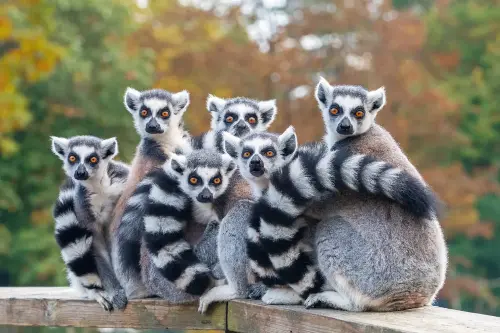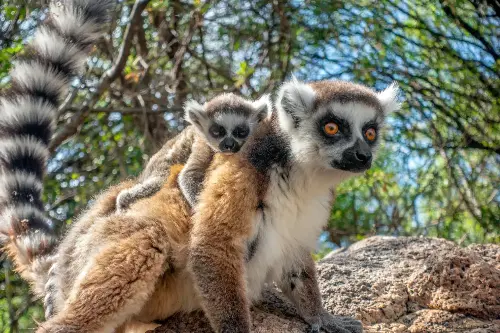Lemurs, with their wide, curious eyes and endearingly human-like behaviours, are the charismatic stars of Madagascar's unique ecosystems. Despite being adored by many around the world, these fascinating primates are among the most imperilled mammals on Earth. There are compelling reasons why lemurs warrant our undivided attention and concern, and as we delve into their world, the imperative to protect them becomes abundantly clear.

Madagascar's Biodiversity and Lemur Evolution
Madagascar, an island that has been isolated for about 88 million years, is a wonderland of biodiversity. Lemurs are at the heart of this, having arrived on the island potentially by floating across the ocean on rafts of vegetation some 50 to 80 million years ago. This geographic isolation has resulted in a spectacular example of what biologists call adaptive radiation: the rapid evolution of a life form into many new species to fill a variety of ecological niches. Nowhere else on the planet can one find a comparable example of this phenomenon with primates.
Diversity and Unique Adaptations of Lemurs
Remarkably diverse, lemurs come in all shapes and sizes, from the tiny 30-gram Madame Berthe's mouse lemur to the indri, which can weigh as much as 9.5 kilograms. Each species has adapted to its specific environment in extraordinary ways. The aye-aye, for instance, possesses a long, thin middle finger to extract grubs from trees, a method of feeding that is completely unique among primates. The bamboo lemur, on the other hand, can digest large quantities of bamboo that contain cyanide, a compound that is toxic to almost all other animals.
Social Structure and Behaviour
Equally fascinating is the lemur social structure. Many lemur species, like the ring-tailed lemur, have matriarchal societies, a rarity among mammals. Females dominate the groups, leading the troops and having the priority for food and mate selection. The hierarchy extends to offspring, with the young of high-ranking females inheriting their mothers' status. On the other side of the spectrum, the sifaka, with its long, powerful legs, performs an elegant, bipedal dance to navigate between trees, making it one of the most balletic movers in the animal kingdom.

Threats Facing Lemurs
However, despite their evolutionary success and the joy they provide to those who observe them, lemurs are on the brink. As of the last assessments, 98% of lemur species are threatened, making them the world’s most at-risk group of mammals for extinction. Many are listed as endangered or critically endangered by the International Union for Conservation of Nature (IUCN). The reasons for this are manifold and intertwined with human activity.
Conservation Challenges
Deforestation is perhaps the most immediate threat. Madagascar has lost around 90% of its original forest cover due to logging, mining, and slash-and-burn agriculture, destroying the habitats lemurs have relied upon for millennia. Additionally, poverty leads to the hunting of lemurs for bushmeat, further compounding their population decline.
Climate Change and Its Effects
Climate change also looms as a key threat, altering rainfall patterns and increasing the frequency and intensity of droughts, thus changing the availability of the fruits, leaves, and insects that lemurs depend on. The intricate web of life that supports lemurs is being undone at an accelerating pace, with each thread pulled causing ripple effects throughout the ecosystem.
Conservation Efforts and Ecotourism
The good news is that there is a wide—and growing—base of conservation efforts. Local and international organisations are fighting to preserve lemur habitats through reforestation projects and by creating protected areas. Community-based programs are helping to improve the livelihoods of local people by providing alternative and sustainable sources of income, reducing reliance on the forests for survival.
Ecotourism also presents both a promising and challenging solution. The presence of tourists can help support the local economy and generate funds for conservation while also incentivising the protection of lemurs and their habitat. However, it must be managed carefully to avoid disrupting the very ecosystems that the industry relies upon.
The Importance of Continued Research
Research into these primates continues to reveal more about their behaviour, genetics, and their role in Madagascar’s ecosystems, providing critical information that can aid in their preservation. As we come to understand the value of biodiversity for the health of our planet and our well-being, we recognise that every effort made to save lemurs is an investment in the future of Earth’s biological heritage.
Lemurs are more than just a charming face with an enigmatic gaze; they are sentinels of the health of one of the most unique and threatened ecosystems in the world. They deserve more attention not only for their inherent value but also for what they tell us about the state of our natural world. By channelling curiosity into conservation action, people from all walks of life can play a part in ensuring that these extraordinary primates do not fade into the annals of history. We are at a critical juncture where the actions taken today could determine the future of Madagascar's endearing and endangered residents. The time to act for lemurs is now.
